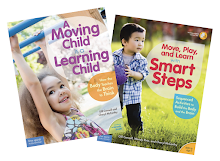According to the Merriam-Webster Dictionary, learning is defined as “to gain knowledge.” And for sure, that is a big part of the journey for all children. But gaining knowledge is only the first step.
In fact, I’d suggest that when we say “learning” we actually mean “understanding,” described by Merriam-Webster as “to grasp the meaning of.”
learn • (verb) • (1) : to gain knowledge or understanding of or skill in by study, instruction, or experience (learn a trade) (2) : memorize (learn the lines of a play)
understand (verb) • (1a) : to grasp the meaning of (understand Russian); (1b) : to grasp the reasonableness of (his behavior is hard to understand); (1c) : to have thorough or technical acquaintance with or expertness in the practice of (understand finance) (1d) : to be thoroughly familiar with the character and propensities of (understands children).
For young children, understanding comes from the natural, everyday weave of her experiences and your language.
I use this example a lot in my workshops…point to the top of your head, then point to the top of your toe. You pointed in two completely different directions. So what does “top” mean? And if “top” is in both of those places, then where is the top of the page?
I use this example a lot in my workshops…point to the top of your head, then point to the top of your toe. You pointed in two completely different directions. So what does “top” mean? And if “top” is in both of those places, then where is the top of the page?
In this case, learning where the top of one thing is won’t tell you where the top of the next thing is. In order to do that, you must understand the meaning of the word in context to the situation -- in other words, to think abstractly. But...
KIDS ARE LITERAL, PHYSICAL BEINGS.
Only after learning “top” in many different ways will they begin to understand that “top” is more than a location, it’s a concept. And to do that, they must experience it – literally and physically -- by pointing to the top, touching the top, crawling along the top, running to the top, reaching the top, and on and on. And while they’re doing that, your use of the word “top” helps them associate what they’re doing with what it’s called. Educators call that “tagging,” an essential teaching tool you do naturally every day.
So, what your child experiences by moving through and manipulating her physical world combined with what you say about those experiences is the magic formula for helping her to go beyond “learning” into the deep and profound world of understanding. I call it…
LANGUAGE + EXPERIENCE = UNDERSTANDING
TOUCH TAG!
This is a wonderfully simple game you can play anytime, anywhere.
Touch Tag helps your child develop physical relationships with words that often have different meanings in different situations. Play it like a scavenger hunt. Here are a few suggestions to get you started…
Can you touch the TOP of your head… toes… nose… table… chair… pillow… toy… paper… pencil, etc.
And, of course, you can play Touch Tag with other directional words. For example, you might try... side… bottom… back… front… left… right… next to, etc.













Another 'Top' post. You have helped me understand how my little one processes the world around her and why I am currently witnessing her confusion/misunderstanding of colours. Fascinating to view this stage now as a physical process-not just a mental one. Intriguing. Thank you
ReplyDeleteMy sister has a couple of toddlers at home, and they are quite a handful but have hearts of gold! As the favourite uncle I get jumped on as soon as I walk through the door, and tag and hide and seek are regular games I have to join in to keep them smiling. This is a great post for someone like me who doesn’t have kids and is still learning all the tricks.
ReplyDelete